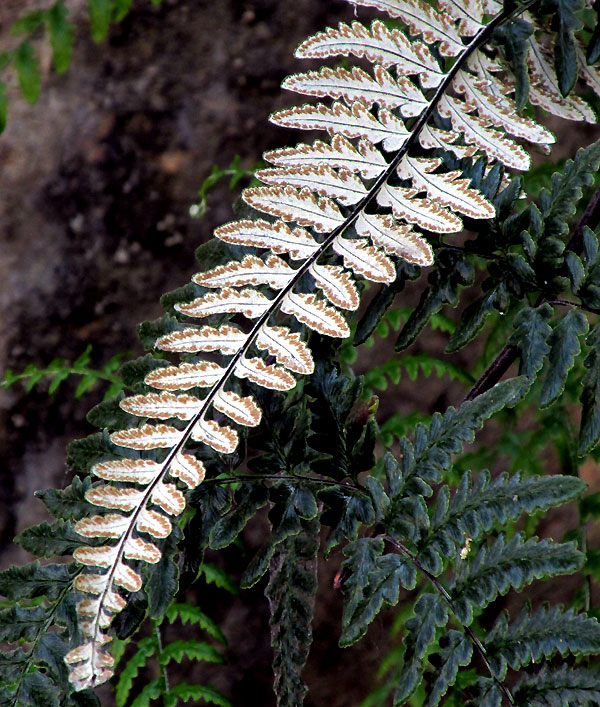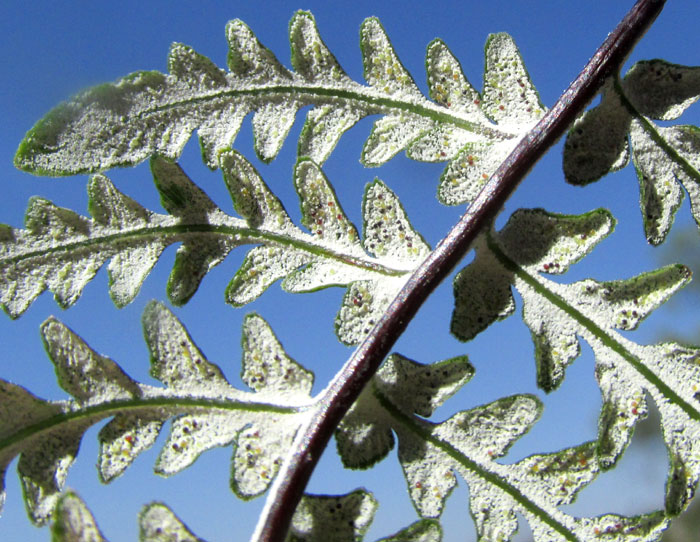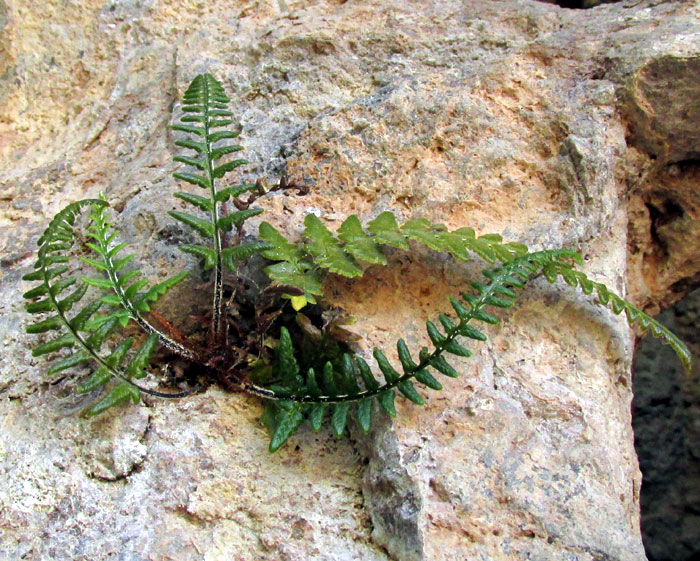Excerpts from Jim Conrad's
Naturalist Newsletter
entry dated May 19, 2022, notes from a camping trip among hills about 7kms ENE of Tequisquiapan, Querétaro state, MÉXICO
elevation about 2040m (6700 ft), near N20.57°, W99.85°
SILVER FERN IN A GROTTO

On the northern edge of the two-small-blocks-wide, hillcrest village of La Higuera, at the base of a tall, vertical rock cliff, there's a wonderful grotto where big ash and baldcypress trees provide blessedly cool, moist shade in the otherwise scrubby, parched-dry landscape. Years ago a shoulder-high stone containment wall was built to pool water below a perpetually flowing little stream issuing through a pipe stuck in the rock, always creating a friendly sounding dribbling sound. Of course at one side there's an altar adorned with faded plastic flowers dedicated to the Virgin. Across the pool of cold water, the bare stone wall is adorned here and there with dark mosses and ferns. The above picture shows the main cluster of ferns.
The light-green fern with confetti-like fronds at the picture's top center are maidenhairs. Here we're considering the dark, long-dangling ones on the picture's left side, the ones with a single frond flipped so that its silvery undersurface makes it stand out. I felt lucky that the frond was flipped, because the undersurface bears spore-producing sori, and the disposition of a fern's sori is critical for its identification.
The grotto was dark and the fern was about ten feet on the other side of the water. To take a picture sharp enough to show sori at that distance the camera was mounted on rocks placed on the stone wall, and a modest telephoto lens and a time exposure of 3 seconds enabled the picture below:

The sori were surprising, not quite like any I'd seen before. The frond's black midrib, or rachis, suggests a spleenwort, but the sori aren't neatly aligned as with spleenworts. Lipferns can have white undersurfaces, and their sori cluster near or below the pinnae's margins, but no lipferns look like this. Pushing Photoshop to the limit, a close-up of part of the above picture was magnified to show more details:

On the cliff wall at the edge of the grotto, away from the water but still in shade most of the day, smaller ferns apparently also Silverbacks were present, and the following pictures were made:

Here's a small one at the drier edge of the community:

Eventually the ferns were identified as PITYROGRAMMA CALOMELANOS, sometimes in English called the Silverback Fern. The name Silverback Fern is used by several fern species, and this one has earned its usage because of its presence in various English-speaking countries. Not only is it reported from the southern US but all through the Americas, and has spread to much of Eurasia and Africa. The authoritative Kew Royal Botanic Gardens website gives its native distribution as Mexico south through much of South America.
However, in the 2021 publication entitled "Helechos Invasivos en México," Salvador González de León and others consider it invasive in Mexico, and declare that along with the Fragile Fern (Cystopterys fragilis), Bracken (Pteridium aquilinum), Maidenhair Fern (Adiantum capillus) and Climbing Fern (Lygodium venustum), Silverback Fern is among the most invasive of terrestrial ferns occurring in Mexico.
In March of 1982, after El Chichón volcano erupted in Chiapas, southern Mexico, a deep cover of sometimes-flowing volcanic ash and rock fragments covered an area of about 6km around the volcano (nearly four miles). When Robert A. Spicer and others visited the area two years later to study the area, in February of 1984, they found that Pityrogramma calomelanos was "the primary colonizer wherever devastation of the pre-eruption vegetation had been intense." Spicer and his group found fronds of the fern up to 1m long (3.3ft) regenerated from rhizomes, and this regrowth apparently had stabilized the soil against erosion. This was reported in their 1985 publication "Pityrogramma calomelanos, the Primary, Post-Eruption Colonizer of Volcán Chichonal, Chiapas, Mexico."
Besides being a vigorous pioneer colonizer in certain environments, weedy in others and an almost majestic presence in certain grottoes, the fronds of Silverback Fern traditionally have been crushed and used as a poultice to promote the healing of ulcers, wounds and cuts. Crushed leaves or the juice from them has been placed in wounds to stop bleeding, plus an infusion of the leaves has been used to treat bronchitis, colds and stomach pains. The fern has been found to contain the sesquiterpene lactone called pterosin, reported to be antibiotic.